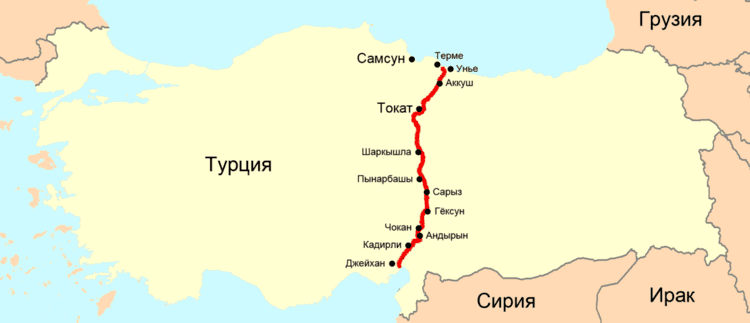From Ünye Commissioned 2014 | General direction north–south Type oil | |
 | ||
Operator Trans Anadolu Pipeline Company | ||
The Samsun–Ceyhan pipeline (SCP), previously called Trans-Anatolian Pipeline, is a planned crude oil pipeline traversing Turkey from the Black Sea to the Mediterranean oil terminal in Ceyhan. The aim of this project is to provide an alternative route for Russian and Kazakhstani oil and to ease the traffic burden in the Bosphorus and the Dardanelles.
Contents
History
The Samsun–Ceyhan pipeline was planned as a Bosphorus bypass. At the beginning of the 2000s, Tun Oil filed for construction of a pipeline from Samsun through Sivas to Ceyhan. In 2003, the Italian energy company Eni studied possible oil transport routes from the North Caspian area. In 2004, based on the pre-feasibility study, the Samsun–Ceyhan route was selected. Another partner in the project, Turkish company Çalık Enerji, carried out technical and commercial studies, and filed for the construction licence on 31 March 2004. One of the route alternatives involved connecting the Kirikkale refinery; however, this option was rejected.
On 26 September 2005, Eni and Çalık Enerji signed a Memorandum of Understanding for their joint cooperation in the project. A pipeline feasibility study was completed in March 2006. The construction licence was granted in June 2006. The Front End Engineering Design Phase was completed at the beginning of 2007, and the ground-breaking ceremony, attended by the Italian Minister for Economic Development Pierluigi Bersani and the Turkish Minister for Energy and Natural Resources Hilmi Güler, was held in Ceyhan on 24 April 2007. In 2008, it was decided to move the starting point from Terme in Samsun Province to Ünye in Ordu Province.
On 19 October 2009, at a ceremony held in Milan Italy, Russia and Turkey signed an intergovernmental agreement guaranteeing a stable regulatory framework and agreeing to the participation of Russian oil companies in the pipeline project. At the same ceremony, Eni and Çalık Enerji signed a Memorandum of Understanding with Transneft and Rosneft to include Russian companies in the development of the project.
On 27 March 2013, Turkish energy minister Taner Yildiz announced that Eni would not be allowed to go forward with the project due to company's plans for the natural gas exploration off Cyprus, and that the pipeline's project may be suspended if Çalık continues their partnership with Eni.
Technical features and financing
The project consists of the new unloading terminal and tank farm, a pipeline from the Ünye terminal to Ceyhan, and additional storage capacity in Ceyhan. It will be connected with the existing Ceyhan loading terminal.
The length of the pipeline will be 550 kilometres (340 mi). Starting from Sarız, the pipeline will follow the Baku-Tbilisi-Ceyhan pipeline's corridor. The diameter of the pipe will vary from 42 inches (1,070 mm) to 48 inches (1,220 mm). It will have four pumping stations and one pressure-reducing station. The designed capacity is 1.5 million barrels per day (240×10^3 m3/d) and initial capacity is 1-million-barrels-per-day (160,000 m3/d). The tank farm in Samsun will have a storage capacity of 6 million barrels (950,000 m3) and the additional tank farm in Ceyhan 8 million barrels (1.3×10^6 m3).
The pipeline is scheduled to become operational in 2012. The project costs are expected to be around $2 billion.
Pipeline company
The pipeline will be constructed, owned and operated by the Trans-Anatolian Pipeline Company (TAPCO), a joint venture of Eni and Çalık Enerji incorporated in Turkey. In 2006, it was announced that Indian Oil Corporation will have a 12.5% stake in the project; however, this deal was not completed. Also Royal Dutch Shell and Total S.A. had expressed their interest in the project. In 2009, it was decided that the new partners in the project will be Rosneft and Transneft, while Lukoil and Kazakhstan have expressed interest in participating in the project.
Environmental impact
Ships passing through the Turkish Straits (the Bosporus and the Dardanelles) currently carry 120 million barrels (19,000,000 m3) of crude oil annually. This figure is expected to exceed 250 million barrels (40,000,000 m3) in the next 10 years. Tanker traffic in the Straits is expected to decrease by 50% when the Samsun–Ceyhan pipeline becomes operational.
